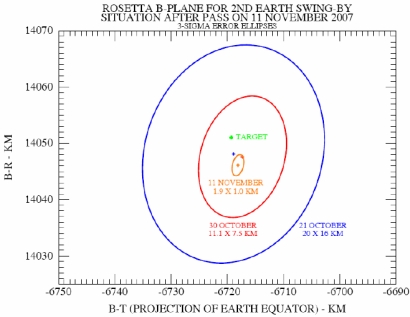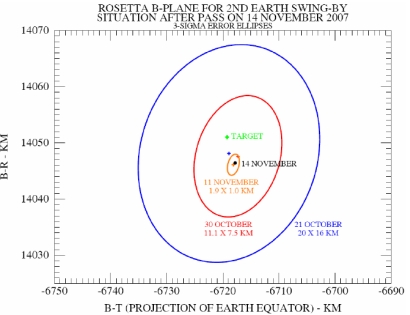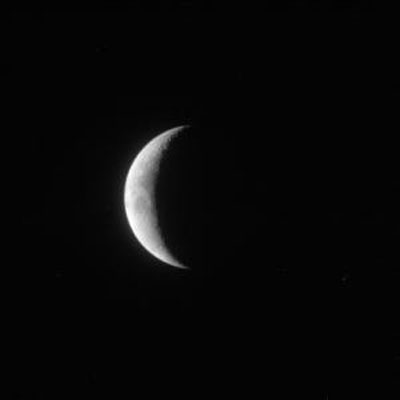No. 90 - Earth Swing-by Activities
No correction manoeuvres were needed in the days preceding the swing-by. Orbit determination and manoeuvre optimisation performed after the swing-by confirmed the need for a small correction. In order to optimise the fuel consumption the manoeuvre will be split in two legs (one to be performed on the 23 November, the second in February 2008).
Several instruments have been operating during the reporting period producing a significant amount of science data, now being processed by the PI teams.
| DOY | Date | Pass | Main Activity |
| 314 | 10/11/07 | DSS-15 1351 | Tracking Pass |
| NNO 1351 | Tracking Pass | ||
| 315 | 11/11/07 | DSS-15 1352 | Tracking Pass |
| NNO 1352 | Switch RF link to HGA-S | ||
| 316 | 12/11/07 | DSS-24 1353 | Tracking Pass |
| NNO 1353 | Switch RF link to LGA-S, start science ops | ||
| 317 | 13/11/07 | DSS-24 1354 | Tracking pass |
| NNO 1354 | Monitor pre closest approach | ||
| AGO 0 | Tracking pass for radio science purposes | ||
| DSS-24 1355 | Monitor post closest approach | ||
| NNO 1335 | Science data downlink | ||
| 318 | 14/11/07 | DSS-24 1356 | Science data downlink |
| NNO 1356 | Science data downlink | ||
| 319 | 15/11/07 | DSS-24 1357 | Tracking pass |
| NNO 1357 | Science data downlink | ||
| 320 | 16/11/07 | DSS-26 1358 | Tracking pass |
| NNO 1358 | Switch RF link back to HGA-X, science data downlink |
At the end of the reporting period (DOY 320) Rosetta was at 1.75 million km from Earth (0.011 AU); one-way signal travel time was 6 seconds. The distance to the Sun was 145.65 million km (0.98 AU).
Spacecraft
Payload
During the reporting period some of the instruments have started the activities linked to the Earth Swing-by 2 observation campaign.
ALICE
The instrument has been operating during the swing-by from DoY 314.18:45. Few out of limits have been recorded and are being analysed. None of them is of concern. The instrument will be switched OFF on DoY 321.16:10.
CONSERT
Instrument is OFF.
COSIMA
Instrument is OFF.
GIADA
Instrument is OFF.
MIDAS
Instrument is OFF.
MIRO
The instrument is taking part to the swing-by campaign with several observations as from DoY 317.12:05. The MIRO operations will finish on DoY 322.12:15.
OSIRIS
The instrument was commanded to take several images of the Earth and the Moon during the Earth Swing-by. Operations of the instrument went very smoothly as from activation on DoY 315.07:40. The instrument finished the ESB2 operations on DoY 320.11:50.
ROSINA
Instrument is ON (RTOF in stand-by) as part of an out-gassing attempt.
RPC
The instrument has been operating since DoY 311.01:10 with MAG and LAP and will continue till DoY 324.14:00.
RSI
Instrument is in muted status.
VIRTIS
The instrument was operated during the swing-by as from DoY 317.16:54. The instrument finished the ESB2 operations on DoY 319.00:55.
LANDER Philae
The ROMAP instrument was activated on DoY 311.00:00 and will be switched OFF on DoY 324.14:10.
SREM
Since DoY 248/2007 the accumulation settings are configured for active cruise mode.
Future Milestones
The Earth Swing-by phase will continue now with the remaining payload operations and the first trajectory correction manoeuvre planned for 23 November. The intense navigation campaign will finish shortly after.
The mission control teams are now planning check-out and tests in preparation of the Asteroid fly-by of September 2008.
Earth Swing-by 2
On DoY 317 at 20:57:22.964 UTC Rosetta flew at an altitude of 5294.852 km over the surface of the Earth for its 2nd swing-by. Rosetta will swing-by again the Earth on 13 November 2009 for its 3rd and last swing-by on its way to comet 67P/Churyumov-Gerasimenko.
The Rosetta Earth swing-by has also been characterised by warning and alarms regarding potential hazards for the Earth coming from an asteroid that would fly only 5600 km over the Earth surface in the night of 13 November. It is interesting to note that this hazard was Rosetta approaching the Earth and the high-quality of the orbit determination of these alert centers.
In the night of the swing-by the mission control team at ESOC was also informed of an object following Rosetta on a very similar orbit and coming from Mars (as Rosetta). Further analysis revealed in this case that the object was an asteroid with an Apollo-type orbit.
Targeting
On the following plot, the blue cross and surrounding 3-sigma error ellipse and red cross and surrounding 3-sigma error ellipse were estimates for the location in the Rosetta B-plane, corresponding to the 2nd Earth swing-by, that were made using data up to 21 October and 30 October respectively.
Using data up to the end of the NNO pass on 11 November, the orange cross and surrounding 3-sigma error ellipse show the current estimate in the B-plane. The location is 5.0 km from the optimum target.
 |
The target location corresponds to a perigee altitude of 5299.5 km (relative to the Earth's equatorial radius). The estimate corresponds to an altitude of 5294.7 km with a 3-sigma uncertainty of 1.5 km.
Performance Analysis
Using data up to the end of the New Norcia pass that finished 14 November, the black dot on the plot below shows the final estimate in the Rosetta B-plane, corresponding to the 2nd Earth swing-by. This estimate is less than 500 m from the last estimate made before the swing-by, using data up to 11 November. The estimate is 4.8 km from the optimum target.
 |
The associated 3-sigma error ellipse is not shown because it would be too small to see clearly. Its semi-major axis is about 10 m and its semi-minor axis is less than 5 m.
The final estimate corresponds to a perigee altitude of 5294.852 km (relative to the Earth's equatorial radius). The 3-sigma uncertainty of this result is 7 m.
The time of closest approach was 20:57:22.964 UTC on 13 November. The 3-sigma uncertainty of this result is less than 0.005 seconds.
Images
Apollo Type Asteroid
Based on orbital elements provided by JPL the closest approach to Rosetta was on 13 November at 20:46 UTC (11 minutes before Rosetta's perigee passage) with a miss-distance of 346,708 km (slightly less than Earth-Moon distance).
The asteroid made its closest approach to the Earth on 14 November at 03:19 UTC at a distance of 227,356 km and a maximum speed relative to the Earth was 11.6 km/s. It reached 85 degrees south declination and passed almost directly overthe south pole.
Starting from shortly after the Earth fly-by and for the whole of 2008, the asteroid will not be observable either because its direction is too close to that of the Sun or because it is too distant from Rosetta which will limit a definitive orbit determination for several years.




